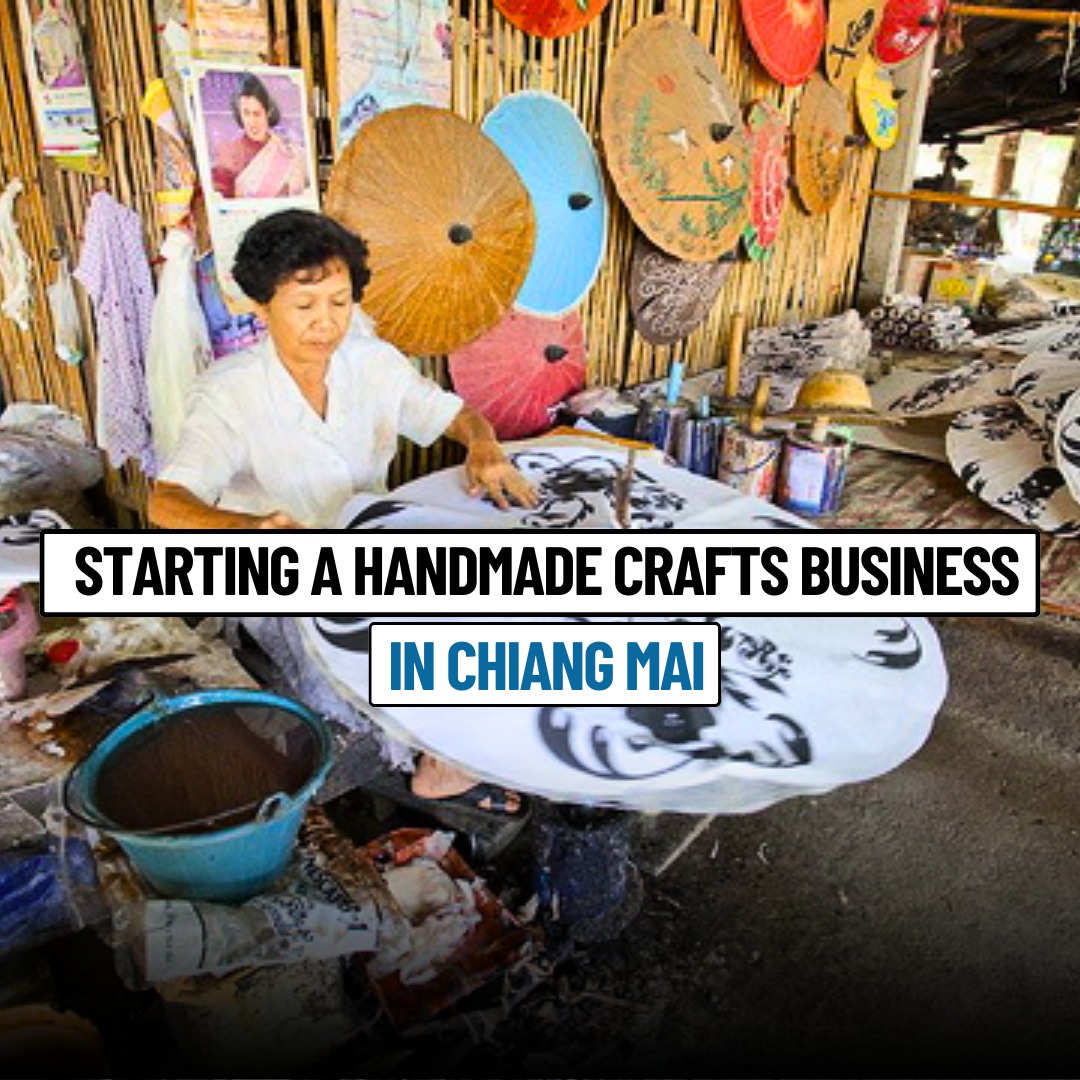Chiang Mai, also known as the cultural heart of North Thailand, is the craft center of the country. More than a tourist hotspot, it is an attraction for craft lovers and artisans. With the culturally built heritage of crafts, weaving and wooden carving, Chiang Mai has the inbuilt ecosystem for launching a handicraft business with a great tourist attraction across the globe. If you are a foreigner looking for guidance to build a handicraft business empire in Thailand from scratch, this article will guide you in turning your plan into the best-executed procedure while following the step-by-step model.
1. CHOOSE YOUR PREFERRED CRAFT NICHE
The roots of every successful story lie in the foundation. So, before setting up your business, identify the niche, research what you want to sell, how you will produce or source those products, and your customer type. Chiang Mai’s art culture is vast and creative; however, standing as an odd one out requires innovative ideas. These innovations should be balanced with the authenticity and cultural heritage of Thailand. Try to draw a roadmap from scratch, from resources to the finished products. Some popular handicraft categories are silk and cotton textiles, bamboo crafts and furniture, paper crafts, ceramic and pottery, tribal or silver jewellery and herbal products.
Remember the market trends and customers’ attractions while choosing the craft niche.
2. DEFINE YOUR BUSINESS MODEL
After deciding on the niche of your handicraft business, define your business model. It will help you decide your investment, scale, growth potential, and expected profits. Some of the proven models for craft entrepreneurs in Chiang Mai are:
• Direct-to-Consumers
• International exports through e-Commerce
• Wholesale distribution
• Workshops for Tourists
Finalising your niche and model will enable you to build a clear map to attract the customers you need while pursuing a successful business.
3. UNDERSTANDING THE REGISTRATION & LEGAL COMPLIANCE
For a foreigner to operate a handicraft business in Thailand, one must go through a strict legal compliance and registration process under the Foreign Business Act of 1999 (FBA) regulations. The handicrafts business comes under List 2, where foreign investors must get a Foreign Business License and file an application to set up a business. The following are the requirements to fulfil for a Foreign Business License:
• Business Registration: The first step is to register your company name with the Department of Business Development (DBD) with all the necessary documents prescribed by the DBD.
• Work Permit/Non-Immigrant Visa: Foreigners planning to start a business in Thailand must obtain a proper Non-Immigrant visa or a work permit.
• Minimum Capital: The minimum capital investment for a business under List 2 must be at least three million Baht.
• Thai Partner and its shares: The most crucial requirement is that two-fifths of the directors must be Thai nationals. Thai investors must hold at least half of the company’s shares.
• Foreign Business License: A foreigner has to apply for a foreign business license (FBL) under the Ministry of Commerce, which is approved by the Cabinet. With professional assistance, it takes 3-4 months.
Once you get a license, you can hold more than 49% of the capital investment in the company. If you expect the company’s revenue to be more than 1.8 million Baht annually, apply for VAT and tax ID Registration.
4. COLLABORATION WITH LOCAL SUPPLIERS AND ARTISANS
When it comes to crafts, the greatest strength of Chiang Mai lies in the local suppliers and artisans of the villages. You can network with skilled artisans and collaborate to create famous and traditionally made craft products. This will create a beneficial business for you while indirectly employing the locals for your business. Some places are renowned for specific crafts, such as villages like Ban Tawai for wooden crafts and Bo Sang for paper crafts, where generations are trained in craftsmanship. Moreover, partnering with local artisans will give you a better reach of customers with cultural fondness and strengthen your brand’s credibility. However, as Thai artisans require, ensuring fair pay and respect from your side is essential.
5. SETTING UP A STUDIO OR SHOP
Choosing an appropriate space is integral in setting up a handicraft business. The city offers everything from creative studios in nature to shops in the centre of the market. Many people start their craft business from a small studio in a peaceful but touristy place. You can also get workshops and co-working spaces if your budget is restricted. However, if you plan to start a D2C business, consider a preferred market such as Sunday Walking Street or Jing Jai Market. This will help you connect with tourists as well as locals. These places will help you expand your sales with lower rent costs.
6. REACH YOUR AUDIENCE
While finalising the setup of your business, you need to bring your brand to life with a story, values and identity. A well-designed logo, packaging, and advertisements that reach the people are essential to the customer experience. Additionally, presenting your story and goals is even more critical. Your values are necessary in every step of your brand’s progress.
Thus, marketing has to be done on the ground level and on online platforms. Participating in local markets gives instant feedback and allows you to build early fame in the market. Moreover, you can also collaborate with restaurants, tourism agencies, and resorts to feature cultural heritage. You can also offer crafting workshops while collaborating with local artisans to attract tourists.
On the other hand, you can upload your products to online platforms like Etsy, Amazon Handmade, and other Thai-based platforms to reach a global customer base. Get a website for your brand’s name and connect with customers through social media to grab a large audience base. Share your creative journey through storytelling while promoting the traditional culture of generations-based craftsmanship.
7. MANAGE PRODUCTION AND INVENTORY
A business owner needs to carefully manage the production and inventory while balancing craftspersons’ creative and consistent efforts. Although handmade items are subject to the availability of seasonal materials and their demands, the owner has to ensure a constant production while ensuring tourist seasons and online sales cycles. Keep a check on your inventory through databases for multiple artisans and suppliers. Good production and inventory management keep the prices under management and ensure consistency in business while growing sustainability.
8. UNDER FINANCIALS AND GROWTH POTENTIAL
Once your business progresses, try to expand your operations. Hire staff, invest in equipment or expand your product range. You may also initiate reaching other countries and entering the wholesale market while expanding your boundaries. Try to collaborate with organisations which follow sustainability and cultural heritage. Start your business with a balanced launch with a minimum expenditure of 80,000 Baht and invest more as the potential growth gradually increases.
9. WHY NOW?
With the rising inclination toward handmade and traditional goods, this is the golden opportunity to initiate your business in the cultural heart of Chiang Mai. Whether you want to sell bamboo crafts or wax-based products globally, this city is the best option for authentic and creative handicraft businesses in Thailand.
BY- Shabadpreet Kaur
- The Making of a Malkin: The Inspiring Tale of Nish Hair
- Snitch: From Hustle to Hype — The Story Behind India’s Boldest Men’s Fashion Brand
- STARTING A HANDMADE CRAFTS BUSINESS IN CHIANG MAI
- SUGAR COSMETICS: BEAUTY FOR EVERY SHADE OF INDIA
- From Mandaps to Mobile Apps: How Shaadi.com Redefined India’s Marriage Industry






